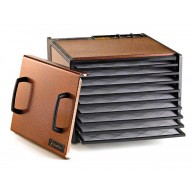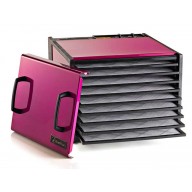Here are 15 great reasons to dehydrate food
(Compliments of “TheWeekendPrepper.com”)
Dehydrating food is a great skill to learn. It is easy to do, can be done with no equipment (but you will get much better results with a dehydrator) and offers many benefits to your long term storage. Dehydrated foods are long lasting, light weight, require no refrigeration and can be eaten as is with no additional cooking or preparation, all key ingredients for a food storage program. Let’s take a few moments to explore the many benefits of learning the skill of dehydrating food. Below you will find 15 reasons that dehydrating and a food dehydrator should be core additions to your long term preparedness plans. Convenience and ease of storage – Dehydrated foods are easy to store. They take up less space than canned or frozen foods. That means that you can store more food in what may be a limited space dedicated to your food storage program. They are also convenient. They can be eaten as is with no further preparation. And when it comes to cooking with them, just add a bit of extra water and the foods will plump right back up as they absorb the water. Great for emergencies – Because dehydrated foods can be eaten as is, they are a perfect emergency food. Just open a pack of dehydrated apples, peppers, beef jerky and eat. So even when you have no lights, no way to cook and no extra water, you can always eat some nutritious, tasty food right out of the bag. Does not spoil – Dehydrated foods, when sufficiently dried, do not require refrigeration and will not spoil Due to the very low moisture content, dangerous organisms like molds, years and bacteria won’t be able to grow on your food. And if you are concerned with moisture, you can add a water absorbing pack to your storage container before sealing it. Light weight – Because the food is dehydrated, it is very light weight. This makes it easy to carry and perfect for a bug out bag or for general outdoor hiking and related activities when you want to minimize weight. Opportunity for food savings – Even if you don’t have a garden, you know that the supermarkets always have great sales on fruits and vegetables when they are in season. Since dehydrated foods can easily be stored for a year if properly prepared, you can buy a huge supply of whatever items are in season (and inexpensive), dehydrate them and enjoy your banked savings the rest of the year. Nutrient Rich – Since dehydration is done at such a low temperature (except for products like beef jerky), the food is considered a raw food and thus contains all its enzymes, vitamins and other nutrients that may become damaged by cooking. Therefore when you start a meal with dehydrated fruits and vegetables as the base, you will be starting with very close to the same nutritional profile as fresh, raw foods. Set it and forget it – If you are using a temperature regulated food dehydrator (as opposed to sun drying), you have the ability to strictly control the temperature of the unit. This allows you to set it up and just let it run while you do other things. You will only have to check on it from time to time to maybe rotate trays or to see if it is done as air humidity can affect the length of time it takes to complete. But for the most part, dehydrators are like crock pots – nice, easy and mostly hands free once you start the process. Great taste – Dehydrated food has the same great taste as the original foods with the advantage that the taste is more concentrated and really comes out as you chew it and it gets rehydrated in your mouth. Plus, since you have the opportunity to dehydrate at peak season for each item, you will always be enjoying the food at its peak flavor point, something that you can’t do when buying fresh foods off of peak season. No preservatives/additives – Just about any food you buy in the store has had things added to it – sugars, preservatives, additives, etc. They do this to extend shelf life and to restore flavors to foods that were not picked at their prime or leached out in the preparation process. With dehydrated foods, it is just the food itself. No extra ingredients. So you know you are getting wholesomely good food in every bite. Cost savings – Since you can dehydrate any time, you can take advantage of bulk buys, in season buys, buys direct from the farm, etc. to minimize the investment in the food that you dehydrate. It is also a good way to preserve foods when you accidentally bought too much and are in risk of losing some to spoilage. (Let’s face it – we’ve all had times when we open the refrigerator and find something that has been sitting for way too long.) Quality control – You control the quality of the food you purchase fresh and dehydrate. You choose each piece, clean and prepare it yourself and when it comes time to eat, you have confidence that you are eating food that you personally inspected. You really don’t know what you are getting when you open a can of food. Better snacks – Not everything has to be about preparing for a disaster. Use your dehydrator to make healthy snacks, granola, etc. Remember, you can always add other items to your dehydrated foods to make your own delicious versions of trail mix with nuts, chocolates, etc. Raw food – For some folks, a raw food diet is a lifestyle choice and a dehydrator is the perfect kitchen appliance to help make a variety of interesting raw foods. A dehydrator can be set at 115 degrees or less to keep the food completely biologically active which is perfect for a raw food diet. And a dehydrator is versatile. In addition to dehydrating fruits and vegetables, it can also be used to make raw crackers, breads, granolas, cookies, veggie burgers and so much more. It is truly a versatile cooking appliance. Cuts down on waste – Basically, you can dehydrate any time so if there is overflow in the garden, kick up the dehydrator. If you have lots of excess pieces of vegetables in the refrigerator, dehydrate them and save them for the next time you make a stew. These are just two of many opportunities to ensure maximum utilization of all foods that enter your home. Peak season quality – Although mentioned in a few other points, it is worth repeating. Most of the fresh fruits and vegetables we buy in the supermarket are picked too early, shipped 1000′s of miles and then put on the shelf waiting for you to buy. This is not optimal food. But once every season, you have the opportunity to buy some selection of reasonably local food that was actually harvested and offered to you at the optimal time. You will know when this is by the sales in the supermarket. Prices drop when local produce is coming online because it gets to the supermarket fast and they want to move it out fast. This is the time to buy, both to save money and to capture the optimal nutritional profile for the food you are storing away. As you can see from these 15 points, dehydrating food is a sensible lifestyle choice for anyone interested in building a sensible, nutrient rich medium term food storage program. A simple dehydrator can be bought very cheaply and will allow you to experiment but a really good one only cost a few hundred dollars and is well worth considering if you are serious about incorporating food dehydrating into your daily activities. Here are a variety of low cost and professional food dehydrators that will all help you get started on this healthy food alternative:
5-Tray Excalibur Dehydrator w/Timer
9-Tray Excalibur Dehydrator w/Timer




